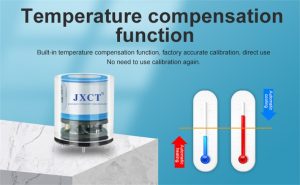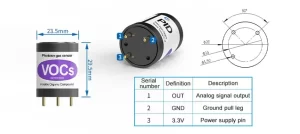Air pollution is a major concern for public health, as it can lead to a wide range of health issues including respiratory diseases, cardiovascular diseases, and even premature death. With the increasing urbanization and industrialization, the levels of air pollution have been on the rise, making it crucial to monitor and control air quality.
One of the key tools in monitoring air quality is the use of gas sensors. Gas sensors are devices that can detect the presence of various gases in the air, and are widely used in environmental monitoring, industrial safety, and indoor air quality monitoring. In recent years, there have been significant advancements in gas sensor technology, which have led to more accurate, reliable, and cost-effective sensors.

One of the major advancements in gas sensor technology is the development of advanced materials for gas sensing. Traditional gas sensors often use metal oxide semiconductors as the sensing material, which have limitations in terms of sensitivity, selectivity, and stability. However, researchers have been developing new materials such as metal-organic frameworks, carbon nanotubes, and graphene, which offer improved performance in gas sensing.
These advanced materials have unique properties that make them suitable for gas sensing applications. For example, metal-organic frameworks have high surface area and tunable porosity, which allows for the selective adsorption of specific gas molecules. Carbon nanotubes and graphene have high electrical conductivity and large surface-to-volume ratio, which enable fast and sensitive detection of gas molecules.
In addition to advanced materials, there have been advancements in sensor fabrication and integration. New manufacturing techniques such as inkjet printing, aerosol jet printing, and screen printing have enabled the production of low-cost, flexible, and scalable gas sensors. Furthermore, advancements in microelectronics and wireless communication have allowed for the development of miniaturized and networked gas sensor systems, which can be deployed in a wide range of environments for real-time monitoring of air quality.
Another key advancement in gas sensor technology is the development of sensor arrays and data processing algorithms for multi-gas analysis. Traditional gas sensors are often limited to detecting a single gas, which can be insufficient for comprehensive air quality monitoring. However, sensor arrays consisting of multiple gas sensors can provide information on the presence and concentration of multiple gases in the air. Furthermore, advanced data processing algorithms such as machine learning and pattern recognition can be used to analyze the sensor data and identify the sources and trends of air pollution.
The advancements in gas sensor technology have opened up new opportunities for monitoring air quality in various applications. For example, in urban areas, gas sensors can be deployed in smart city infrastructure to monitor air pollution levels in real-time, and provide valuable data for urban planning and environmental policy-making. In industrial settings, gas sensors can be used to monitor emissions from factories and power plants, and ensure compliance with environmental regulations. In indoor environments, gas sensors can be integrated into HVAC systems to control ventilation and maintain healthy indoor air quality.
Despite the advancements in gas sensor technology, there are still challenges and limitations that need to be addressed. For example, the long-term stability and reliability of gas sensors need to be improved, especially in harsh and complex environments. Furthermore, the calibration and maintenance of gas sensors can be a challenge, as they require periodic calibration and replacement of consumable parts. Additionally, the cost and power consumption of gas sensors need to be reduced to enable widespread deployment in resource-constrained settings.

In conclusion, the advancements in gas sensor technology have significantly improved the capabilities of monitoring air quality. The development of advanced materials, sensor fabrication techniques, sensor arrays, and data processing algorithms have enabled more accurate, reliable, and cost-effective gas sensors for environmental monitoring. With continued research and development, gas sensor technology has the potential to play a crucial role in addressing the challenges of air pollution and ensuring a healthier and more sustainable environment for future generations.
 : +86 155 8830 2704
: +86 155 8830 2704 : jxdziot@gmail.com
: jxdziot@gmail.com
